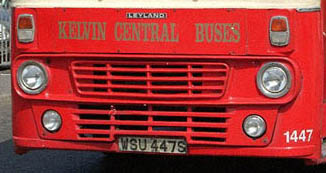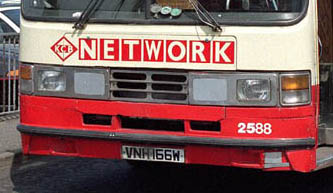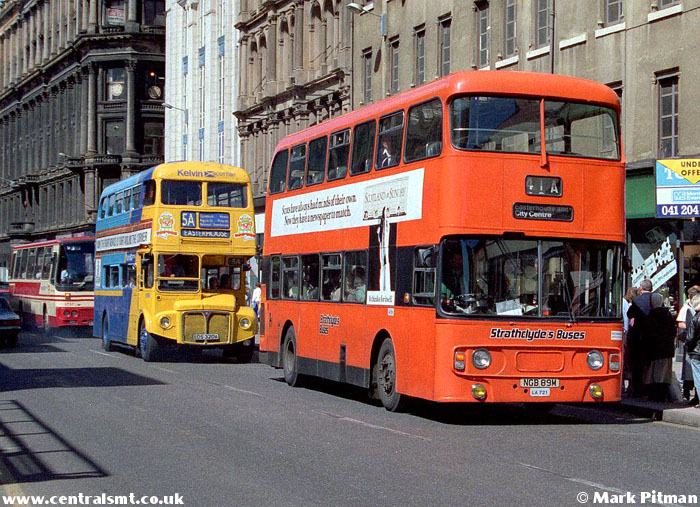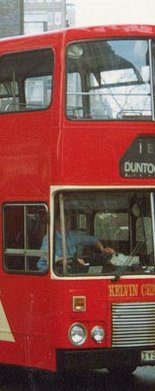The Central Story
1989 - 1994 : Kelvin Central
The fully merged Kelvin Central Buses Ltd. was formed on 17 July 1989 by order of the Government, as a supposedly necessary step in the privatisation of the Scottish Bus Group. The new company combined the Kelvin Scottish operations to the north-west, north and north-east of Glasgow with the stricken remains of Central Scottish in Lanarkshire. Interestingly, the move re-united the Dunbartonshire operations based at Old Kilpatrick Depot with those in Lanarkshire.
 Although the combination of Kelvin and Central was widely described as a merger, and despite the new company's Head Office being in Motherwell, it was clear from the start that Kelvin management were in control. The new management took swift and draconian action to try to turn round the company's fortunes and prepare it for life in the private sector. Whether their actions could properly be described as punitive (i.e. in direct retaliation for the Central strikes) is a subjective matter that is open to interpretation. What is undeniably true is that it was two former Central garages, Wishaw and East Kilbride, that were targeted for rapid closure. East Kilbride is a particularly notable example, as the depot served Scotland's second largest (at the time) and fastest-growing town. The depot was, however, also regarded as one of the most militant in the Central fold.
Although the combination of Kelvin and Central was widely described as a merger, and despite the new company's Head Office being in Motherwell, it was clear from the start that Kelvin management were in control. The new management took swift and draconian action to try to turn round the company's fortunes and prepare it for life in the private sector. Whether their actions could properly be described as punitive (i.e. in direct retaliation for the Central strikes) is a subjective matter that is open to interpretation. What is undeniably true is that it was two former Central garages, Wishaw and East Kilbride, that were targeted for rapid closure. East Kilbride is a particularly notable example, as the depot served Scotland's second largest (at the time) and fastest-growing town. The depot was, however, also regarded as one of the most militant in the Central fold.
In the immediate aftermath of these closures, and before further retrenchment would force another wave of changes, some rather strange operating procedures were tried. Front-line East Kilbride - Glasgow services were combined with Cumbernauld - Glasgow services and Cumbernauld-based Ailsas were given the task of running through journeys on the Cumbernauld - Glasgow - East Kilbride corridor. Additionally, Kirkintilloch-based double-deckers - complete with Kirkie Bus branding - worked routes from Glasgow to Stonehouse (54) and Newarthill (55), via Uddingston and Hamilton. These arrangements were relatively short-lived and Kelvin Central soon abandoned East Kilbride to Strathclyde Buses, retaining only the 201 link with the rest of Lanarkshire.
 Despite all these upheavals in the interests of viability, the company's transition into the private sector was far from easy. Stagecoach is widely rumoured to have been a front-runner as potential buyer, but their management were reputedly scared off once they had seen the books. In the event, the company passed to an employee buyout in 1991 for a token amount, but with the new owners assuming the company's onerous debt burden.
Despite all these upheavals in the interests of viability, the company's transition into the private sector was far from easy. Stagecoach is widely rumoured to have been a front-runner as potential buyer, but their management were reputedly scared off once they had seen the books. In the event, the company passed to an employee buyout in 1991 for a token amount, but with the new owners assuming the company's onerous debt burden.
For the first few years in private ownership, the company concentrated on consolidating its position. No new vehicles were ordered until the end of 1993, but in the meantime some fleet standardisation took place through the disposal of certain types and the purchase of second-hand replacements. The plethora of liveries also slowly gave way to a standard red and cream design, similar to the Lanarkshire Bus livery created by Central in its dying days. By 1992, the company had depots at Airdrie, Cumbernauld, Kirkintilloch, Motherwell, Old Kilpatrick and Stepps.
Before long, the company was embarking on a phase of expansion and tidying up in its operating area, by acquiring many of the smaller independents with which it was having to compete. Operators that succumbed to the advances of KCB included names such as McKenna (Uddingston), Coakley (New Stevenston), Green (Kirkintilloch), Morrow (Clydebank) and McKindless (Wishaw). (Some of these names would re-appear later!) The initial standardisation therefore gave way to diversification, with all the incoming vehicles from these varied independent fleets. By far the most interesting acquisition at this time, however, was Stagecoach's Glasgow-based Magicbus operation, which brought further Routemasters, together with Dennis Dart and Volvo B6 midis, into the fleet. Most commentators viewed Stagecoach's decision to sell Magicbus as clearing the way for a possible takeover of Strathclyde Buses.
1994 proved to be a momentous year for the bus industry in the West of Scotland. Stagecoach took over the ailing Western Scottish, while Clydeside 2000 (the northern part of Western that had been severed in 1985, recombined prior to privatisation and separated once more afterwards) put itself on the market. And at the end of September, it was announced that Strathclyde Buses Ltd (now itself in the ownership of its employees) had made a successful bid for Kelvin Central. Hot on the heels of this announcement, Stagecoach - through its new Western Scottish subsidiary - seemed to be launching an attack on Glasgow by registering a group of city services in direct competition with SBL. But these would never take to the road run by Stagecoach-liveried buses. An agreement was reached between Stagecoach and SBL whereby Stagecoach would acquire a 20% stake in the Strathclyde operator. As there was insufficient time for cancellation of the initial round of competitive services, they were operated for a few weeks by Strathclyde buses, bearing 'On hire to Western Scottish' stickers. As 1995 approached, a new era seemed to be dawning.

This excellent photograph, by Mark Pitman, seems to give a physical representation of the fate of Central SMT. Central would give way to Kelvin, which in turn would be swallowed by Strathclyde Buses.
